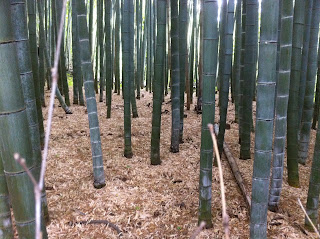1. Zen meditation
Started out the morning with zen meditation led by Reverend Taka, followed by a tour of the Shunko-in Temple. Once the tour was over we got cookies and tea! The cookies were awesome and Yo and I spent a lot of time trying to find them again throughout Japan. We didn't.
 |
| Map of the area in NW Kyoto |
 |
| A sign we saw on the way to lunch |
2. Noorani Indian Restaurant
I would go to Japan again just for this restaurant. It was really awesome. The best Indian food I have ever had in my life. I'm sure it will be in my dreams in the future.
 |
| Best spicy soup ever! |
 |
| Chicken Tikka. OMG. |
 |
| A tapestry at the restaurant |
3. Ryoanji Temple
Checked out Ryoanji temple and the famous rock garden there. I expected a little more after all the rock garden hype, but it was still pretty cool.
History: Ryonaji Temple, originally an aristocrat's country villa, was converted into a Zen temple in 1450. In 1488, the Hojo (abbot's quarters) was restored, and repairs were made to other temple buildings. When these were destroyed by fire in 1797, the Seigen-in Temple's abbot's quarters, built in 1606 was relocated to Ryoanji Temple; this structure is the present Hojo, which serves as the main hall of the temple.
 |
| Kyoyochi Pond. The pond was made in the late twelfth century. Until recent years many mandarin ducks were to be seen on the pond. Hence the Ryoanji was generally known as Oshidoridera, the temple of mandarin ducks. The water wells out from around the two rocks in the south. On the islet named Bentenjima is a hall, in which an image of Sarasvati has been housed. |
 |
| Monkey and the pond |

 |
| Kuri, main building of the temple |
 |
| This simple and remarkable garden measures only twenty-five meters from east to west and ten meters from south to north. The rectangular Zen garden is completely different from the gorgeous gardens of court nobles constructed in the Middle Ages. No trees are to be seen; only fifteen rocks and white gravel are used in the garden. The walls are made of clay boiled in oil. As time went by, the peculiar design was made of itself by the oil that seeped out. This internationally famous rock garden was said to be created at the end of Muromachi Period (around 1500) by a highly respected Zen monk, Tokuho Zenketsu. |
 |
| A rock and gravel garden comprising 15 rocks in five groupings, arranged on a bed of white gravel. It is renowned throughout the world as the ultimate example of the karesansui or "dry landscape" style rock garden, in which nature is compressed and given abstract expression within the confines of a very narrow space. |
 |
| Also known as the "baby tiger crossing" because it resembles a tiger crossing a mountain stream with it's cub. |
 |
| Monkey holding the rock garden |
 |
| School kids hanging out in the temple |

 |
| This pagoda was built in August 1970 as the cenotaph account of the proposition of Joei Matsukura, the 58th chief priest of Ryoanji Temple, who fought at the field automobile operations in the Burma Campaign of World War II. The Pagoda was built in memory of comrades who |
 |
| Don't touch the trees! |
 |
| Stop! |
4. Trolley Train to Arashiyama
Caught the trolley to Arashiyama and had no idea what we were doing or how we were supposed to pay for the trip.
 |
| Monkey on the bridge |
5. Monkey Park
From the station we went to the monkey park which was super cool. There were monkeys everywhere and we were able to get really close to them. Sometimes a little too close. At present, there are about 130 Japanese monkeys at Arashiyama Monkey Park. Each monkey is given a name, and its date of birth is known. This long-term knowledge makes this group of monkeys very interesting for students and researchers, who carry out surveys on various topics. Moreover, there are hundreds of maples in this park. Iwatayama Mountain is well known for its scarlet-tinged leaves in the fall.
 |
| Monkey Park brochure. Doubles as a postcard. |

 |
| Basically Japanese Monkeys are omnivorous, so the can eat almost anything. At the feeding spot, they are fed soybeans, wheat and sweet potatoes three times a day. They also collect food by themselves on the mountain. During summer and autumn, they eat fruit, seeds and insects. Cicadas and beetles are their favorite. During winter and spring, they eat bark and buds off trees. |

 |
| Monkey made a lot of friends |
 |
| I was ready to run. If necessary... |

























































































No comments:
Post a Comment